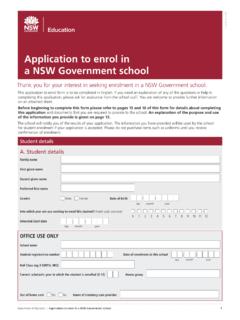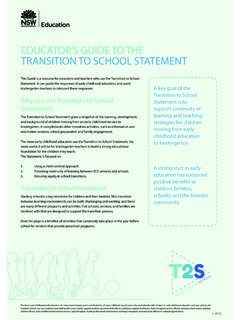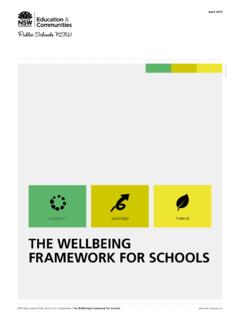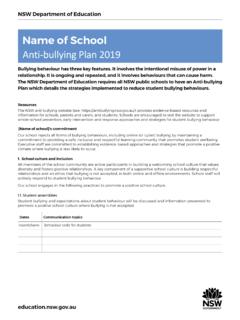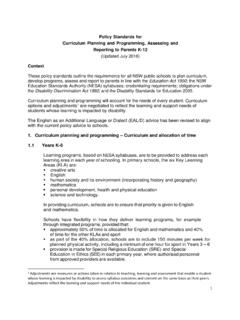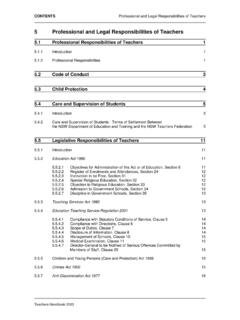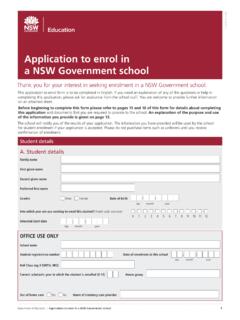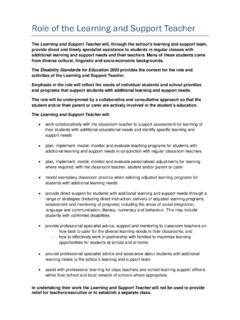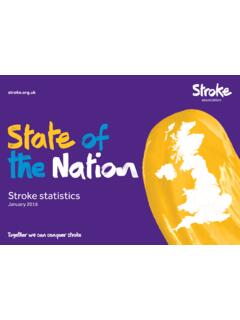Transcription of Student leadership A review of effective practice
1 Student leadership : a review of effective practice Dr Rosalyn Black and Associate Professor Lucas Walsh Monash University Jacqueline Magee, Luke Hutchins, Dr Naomi Berman and Professor Susan Groundwater-Smith Foundation for Young Australians Prepared for the New South Wales Department of Education and Communities. For further information please contact: Student Engagement and Interagency Partnerships NSW Department of Education and Communities 1 Oxford Street, Darlinghurst 2010. Suggested citation Black, R., Walsh, L., Magee, J., Hutchins, L., Berman, N., & Groundwater-Smith, S. (2014). Student leadership : a review of effective practice . Canberra: ARACY. 2. Acknowledgements This What Works for Kids evidence review was the result of a collaboration managed by the Australian Research Alliance for Children and Youth with Monash University and the Foundation for Young Australians.
2 ARACY thanks Professor Robyn Broadbent, College of Education, Victoria University, and Professor Stephen Crump, School of Education, University of Newcastle for their review of the paper. For further information about What Works for Kids evidence reviews, please contact ARACY: Mail: PO Box 5070, Braddon, ACT 2612 Email: Website: Phone: +61 2 6248 2400. ABN 68 100 902 921. 3. Table of Contents Student leadership : a review of effective practice .. 2. Acknowledgements .. 3. List of tables and figures .. 5. Executive summary .. 6. Current theory, policy and practice .. 6. Enablers and barriers to effective implementation .. 9. Key findings .. 12. Introduction .. 13. Current levels of evidence .. 14. Definition of terms .. 14.
3 The practice of Student leadership .. 17. Overview of Student leadership policy .. 18. The international context .. 19. The Australian context .. 21. National action .. 21. State-based action .. 23. Enabling Student leadership .. 25. Enabling Student leadership : policy and systems .. 25. Enabling Student leadership : curriculum, pedagogy and soft 27. Curriculum .. 27. Pedagogy .27. Soft skills and literacies . 29. Enabling Student leadership : the role of community actors 31. Evidence of impact on skill development .. 32. Barriers and challenges to enabling Student 35. Policy and system barriers to Student leadership .35. School-based barriers to Student 39. Exclusion from school governance .. 39. Civics and citizenship curriculum: knowing vs doing.
4 40. Current leadership models: exclusivity and tokenism .. 43. Compounding exclusion .. 44. A need for new models .. 45. The importance of principals and school leaders . 46. Principal perspectives on Student leadership .. 48. Best practice and evidence of 48. Case study .. 52. The design of the project .. 53. Critical moments in the development of students as co- researchers .. 55. 2010: PBIS & KERF: A teacher's response .. 55. 4. 2011: Observing teachers at work .. 56. 2012: Visiting other schools .. 56. 2013: The focus for the 57. Questions of sustainability .. 58. Case study conclusion .. 59. Conclusions .. 60. Enablers and barriers to effective implementation .. 61. Examples of promising practice .. 64. References.
5 69. Appendix 1: Overview of Student leadership initiatives .. 85. Being Heard .. 85. 86. Forums .. 86. Conferences .. 86. Advisory positions .. 86. Multifaceted initiatives .. 86. Creating Change .. 86. Student representative 87. leadership and citizenship activities .. 87. School change .. 87. Community change .. 87. Appendix 2. Being Heard' table of program 88. Appendix 3. Creating Change' table of programs .. 92. List of tables and figures Figure 1: Mitra, D. (2006). Pyramid of Student voice. 7. Table 1: Opportunities for Student leadership 8. Table 2: Enablers of Student leadership 9. Table 3: Barriers to Student leadership 10. Figure 1: Mitra, D. (2006). Pyramid of Student voice. 15. Table 1: Opportunities for Student leadership 17.
6 Table 4: Enablers of Student voice: policy and systems 26. Table 5: Enablers of Student voice: curriculum 29. Table 6: Enablers of Student voice: pedagogy 31. Table 7: Enablers of Student voice: soft skills 33. Table 8: Enablers of Student voice: community 35. Table 9: Barriers to Student leadership : policy and systems 39. Table 10: Barriers to Student leadership : school governance and organisation 40. Table 11: Barriers to Student leadership : practice 42. Table 12: Barriers to Student leadership : exclusive leadership model 44. Table 2: Enablers of Student leadership 62. Table 3: Barriers to Student leadership 63. Table 13: Continuum of Student leadership approaches 66. 5. Executive summary This review presents an overview of the existing evidence on the topic of Student leadership in educational settings.
7 In addition to a high-level literature review of effective interventions, it includes an overview of the broad policy and theoretical trends over the last ten years in both Australian and international contexts. Enablers and barriers to the implementation of effective practices of Student leadership and their implications for Australian schools are identified. A case study is also featured which provides a useful example of the various limitations and barriers encountered when applying Student leadership practices in the school environment. Current theory, policy and practice The concept of Student leadership is often used interchangeably with the terms Student agency, Student voice, and Student participation. Researchers tend to identify a spectrum of activities and practices that constitute Student voice and leadership .
8 For example, Holdsworth has proposed a spectrum of Student voice, participation and leadership that ranges from young people speaking out to sharing decision-making (and) implementation of action . (2000, ). Fielding has constructed a typology that ranges from young people serving simply as a source of data for school and system processes to acting as active researchers who drive change within their schools (2001), while Mitra's pyramid of Student voice ranges from merely being heard to building capacity for leadership (2006, , Figure 1). The necessity of participation and freedom of expression is explicitly stated in the United National Convention on the Rights of the Child, which calls for signatories to assure to the child who is capable of forming his or her own views the right to express those views freely in all matters affecting the child.
9 (UN General Assembly, 1989). Student leadership practices emerge from this rights-based concept, reflecting the potential and importance of young people's capacity to play a role in making the decisions that affect them. As noted in ARACY's The Nest action agenda, evidence suggests young people's participation may have a range of important benefits for the individual, for organisations and for the broader community (ARACY, 2014). Specifically within the educational context, participation and decision-making practices can afford students with the skills necessary for active participation as engaged citizens. 6. Figure 1: Mitra, D. (2006). Pyramid of Student voice, from Increasing Student voice and moving toward youth leadership , The Prevention Researcher, 13(1), p.
10 7. The past two decades have seen a global shift within education policy towards incorporation of Student leadership . Nationally and internationally, policy has increasingly expressed the intent to encourage students to take greater ownership of their learning, to play a greater role within the decision making and change processes of their schools and, ultimately, to have an active role in the democratic processes and structures of civic society. This reflects the longstanding recognition that schools are ideal institutions for transmitting social norms such as civic leadership and participation and for developing the skills and knowledge required to meet these norms. It also follows a longstanding policy tradition that frames schools as institutions that serve a set of agreed public purposes, including the development of young people's ability to participate as citizens and as leaders in their schools and communities.
